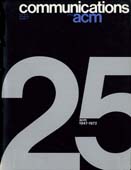July 1972 - Vol. 15 No. 7

Features
Toward an automata theory of brains
Fixpoint approach to the theory of computation
Numerical mathematics and computer science
Management science: a view from nonlinear programming
Towards a general theory of special functions
A view of computer architecture
On the interface between computers and data communications systems
The role of computer system models in performance evaluation
Programming systems and languages 1965-1975
Programming languages: history and future
The production of better mathematical software
Requirements for advanced programming systems for list processing
The evolution of storage structures
On the present and future of scientific computation
A generational perspective of information system development
Language analysis in the humanities
Computers in the instructional process: directions for research and development
The “Plankalkül” of Konrad Zuse: a forerunner of today's programming languages
A western view of computer history
Archaelogy of computers: reminiscences, 1945-1947



